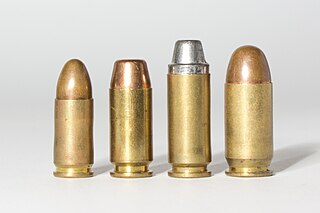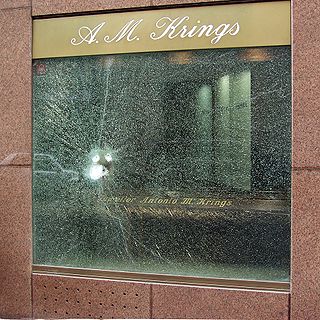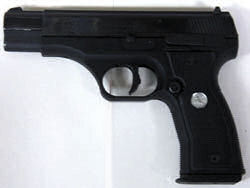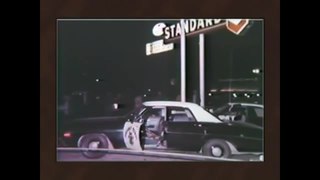
A bulletproof vest, also known as a ballistic vest or a bullet-resistant vest, is an item of body armour that helps absorb the impact and reduce or stop penetration to the torso by firearm-fired projectiles and fragmentation from explosions. The vest may come in a soft form, as worn by many police officers, prison officers, security guards, and some private citizens, used to protect against stabbing attacks or light projectiles, or hard form, using metallic or para-aramid components. Soldiers and police tactical units wear hard armour, either in conjunction with soft armour or alone, to protect against rifle ammunition or fragmentation.

The .38 Special, also commonly known as .38 S&W Special, .38 Smith & Wesson Special, .38 Spl, .38 Spc, or 9x29mmR is a rimmed, centerfire cartridge designed by Smith & Wesson.

Zylon (IUPAC name: poly(p-phenylene-2,6-benzobisoxazole)) is a trademarked name for a range of thermoset liquid-crystalline polyoxazole. This synthetic polymer material was invented and developed by SRI International in the 1980s and manufactured by Toyobo. In generic usage, the fiber is referred to as PBO.

The 9×19mm Parabellum is a rimless, centerfire, tapered firearms cartridge.

Personnel Armor System for Ground Troops is a combat helmet and ballistic vest that was used by the United States military from the early 1980s until the mid-2000s, when the helmet and vest were succeeded by the Lightweight Helmet (LWH), Modular Integrated Communications Helmet (MICH), and Interceptor Body Armor (IBA) respectively.

The FN Five-seven is a semi-automatic pistol designed and manufactured by FN Herstal in Belgium. The pistol is named for the 5.7×28mm cartridge's bullet diameter, and the trademark's capitalization style is intended to emphasize the manufacturer's initials—FN.

A flak jacket or flak vest is a form of body armor. A flak jacket is designed to provide protection from case fragments ("frag") from high explosive weaponry, such as anti-aircraft artillery, grenade fragments, some types of pellets used in shotguns, and other lower-velocity projectiles. It is not designed to protect against bullets fired from most small arms such as rifles or handguns. However flak jackets are able to sustain certain gunshots, depending on the angle at which the shot was fired, the caliber of the bullet, the speed of the projectile and the range from which the shot was fired.

Body armor, personal armor, armored suit (armoured) or coat of armor, among others, is protective clothing designed to absorb or deflect physical attacks. Historically used to protect military personnel, today it is also used by various types of police, private security guards, or bodyguards, and occasionally ordinary citizens. Today there are two main types: regular non-plated body armor for moderate to substantial protection, and hard-plate reinforced body armor for maximum protection, such as used by combatants.

Bulletproofing is the process of making an object capable of stopping a bullet or similar high velocity projectiles. The term bullet resistance is often preferred because few, if any, practical materials provide complete protection against all types of bullets, or multiple hits in the same location, or simply sufficient kinetic (movement) energy to overcome it.
Armor Holdings, Inc. was an American manufacturer of military, law enforcement, and personnel safety equipment. It was acquired by BAE Systems on July 31, 2007 and renamed BAE Systems Mobility & Protection Systems. The divisions have been reorganised within BAE Systems Land and Armaments.

S&W Centennial is a family of revolvers made by Smith & Wesson on the "J-Frame". Depending upon caliber, the cylinder holds either 5, 6, 7, or 8 cartridges. Centennials feature a fully enclosed (internal) hammer, which makes them Double Action Only (DAO) firearms. Like all other "J-frame" Smith & Wesson revolvers, they have a swing-out cylinder. Centennial models have been made in different versions like PD "Personal Defense", LS "Lady Smith", and M&P "Military & Police"

The Colt 2000 or All American 2000 is a polymer or aluminum-alloy framed, locked-breech, rotating barrel, semiautomatic, 9 mm handgun with a magazine capacity of 15 rounds manufactured by Colt.

The Newhall incident, also called the Newhall massacre, was a shootout on April 5–6, 1970, in Valencia, California, between two heavily armed criminals and four officers of the California Highway Patrol (CHP). In less than five minutes, the four CHP officers were killed and another man was pistol-whipped in the deadliest day in California law enforcement history.
Lester D. Shubin was a researcher who developed Kevlar for the use in ballistic vests. Kevlar's use in ballistic vests was later expanded for use in all types of personal armor.
Lee E. Jurras was an American firearm cartridge designer, known for creation of the Super Vel line of cartridges, and groundbreaking developments in hollow-point ammunition.
A tactical reload is the action of reloading a weapon that has only fired a few rounds out of its magazine, and retaining the original magazine. An example is an infantryman reloading before entering a hostile building, concerned about ammunition. Tactical doctrine states that one should always have a full magazine before entering the building or hostile situation, but it is also a bad practice to throw away ammunition in case it is needed.
Second Chance, A Second Chance, The Second Chance, or 2nd Chance may refer to:
On November 23, 2012, Jordan Davis, a black 17-year-old high-school student, was murdered at a Gate Petroleum gas station in Jacksonville, Florida, by Michael David Dunn, a white 45-year-old software developer, following an argument over loud music played by Davis and his three friends, in what was believed to be a racially motivated shooting.

Bleecker Street is an independent American film company that specializes in film distribution. The company is based in New York City and named after 65 Bleecker Street, the street address of founder Andrew Karpen's prior company Focus Features. Founded in 2014, the studio was established with the goal to distribute "smart house" films that combine the entertainment of studio blockbusters with the artistic indie allure.












